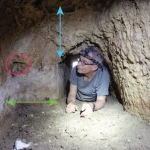Jerusalem, 3 September, 2025 (TPS-IL) — An international team of scientists led by Israeli and U.S. researchers has identified a new type of supernova that offers an unprecedented view into the inner layers of giant stars and how the universe creates the elements essential for life.
The discovery, recently published in the peer-reviewed journal Nature, could reshape science’s understanding of stellar evolution and the origins of matter.
Giant stars are believed to follow an “onion” structure, with lighter elements like hydrogen and helium in outer layers and heavier elements, including iron, concentrated in the core. Until now, observations of supernovae—the explosive deaths of stars—mostly revealed only the outer layers, leaving the deeper regions largely hidden. The newly studied explosion, named SN2021yfj, revealed strong signals of heavier elements, including silicon, sulfur, and argon, offering a rare glimpse into the star’s core.
Although more than 25,000 supernovae have been studied, this is the first time heavy elements have been detected in this way, making SN2021yfj an exceptionally rare and scientifically valuable event.
“For the first time, we have seen a star stripped to its core,” said Dr. Steve Schulze, a former member of Prof. Avishai Gal-Yam’s group at the Weizmann Institute and now a researcher at Northwestern University, who led the study. “The findings teach us how giant stars are built and reveal that they can lose many layers of material and still produce a powerful explosion that can be observed and studied from Earth.”
SN2021yfj, located about 2.2 billion light-years from Earth in a star-forming nebula, was first detected in September 2021 using the Zwicky Transient Facility (ZTF), a wide-field telescope near San Diego, California. To determine the chemical composition of the explosion, scientists analyzed its light spectrum. Early attempts were frustrated by cloudy skies and telescope availability, but a colleague at the University of California, Berkeley, eventually provided the needed data.
“Instead of the helium, carbon, nitrogen, and oxygen usually found in naked supernovae, the spectrum of SN2021yfj was saturated with silicon, sulfur, and argon,” Schulze said.
Previous observations had documented stars shedding only their outer hydrogen layers, exposing slightly heavier elements. SN2021yfj, however, lost more of its outer shells than any star observed before, allowing astronomers to probe deeper layers than ever.
“The star prematurely lost most of the material it had created throughout its life, so we could actually only see the material that was created in the months leading up to the explosion,” Schulze explained.
Dr. Ofer Yaron, a staff scientist in Gal-Yam’s group, added, “Exposing such an inner layer challenges existing theories about mass loss in giant stars and indicates that this is an unusual supernova that occurred by an unknown mechanism.”
Researchers suggest that the star essentially tore itself apart, with its collapsing core triggering powerful fusion processes that expelled outer layers. The unusually bright explosion seen from Earth may be due to collisions between layers ejected at different times.
“This discovery is not just about a star dying in a distant galaxy,” said Gal-Yam. “It shows us where the elements that make up our world—including the silicon in computers, the sulfur in the atmosphere, and even some of the atoms in our bodies—were formed. Every atom around us has a cosmic history, and SN2021yfj gives us a rare look at the stellar factories that create them.”





























